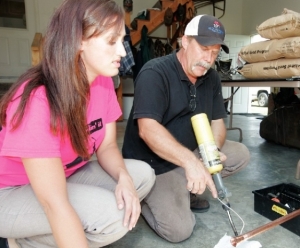Plumbing detail
By Laura Collins
Published in News on June 14, 2010 1:46 PM

Troy Herring
Reporter Laura Collins watches as 15-year Keen Plumbing employee Larry Roberts solders a copper bar before placing a new water heater in a home in Goldsboro.
The Job: Plumber
The Company: Keen Plumbing
The Location: Wayne County
Most of the time I can tell how a job is going to go based on the questions they ask me when I arrive.
I've been asked if I get car sick, how fast I can run in my shoes, and if I'm squeamish. But John Casey, service manager of Keen Plumbing, caught me off guard.
"Are you up to date with all your shots?" he asked.
"I hope so," I said.
We started out working on a stopped-up sewer line at a residence on Bunche Drive. Plumber Joe Thornton was taking the lead and I was a plumber's helper. He gave me goggles and gloves to put on.
"The reason we wear gloves is simple. It's nasty," Thornton said.
Luckily the home had a sewer clean out, which is a capped pipe that extends out of the ground so we can access the sewer line without digging for it. Unfortunately it was a two-way, meaning one part of the pipe ran to the street and the other ran to the house. To unblock it, we needed to use the Electric Eel, a machine that looks like a lawnmower with a metal hose attached to the front. The motorized hose snakes its way through the pipes to push out the clog.
It was my job to hold the Electric Eel while Thornton guided it as it snaked its way through the sewer.
"Whoa, whoa," Thornton said, and I turned off the machine.
Apparently we ran into a minor problem with the two-way sewer. Instead of the hose going through the sewer and turning in the direction of the street, it had looped around and gone in the direction of the house. It was now coming out of a hole in the floor of the garage where a toilet used to be.
"Why do they have a toilet in the garage?" I asked.
"I don't know," Thornton said, shaking his head.
"Why did they take off the toilet and leave an open hole," I asked.
"I don't know."
So we took the hose out and started again. The same thing happened. Since the sewer lines are underground, we couldn't see where the hose was going, so again we were completely surprised when we were looking to the street and the hose popped out of the hole in the garage behind us like it was a snake being charmed out of its basket.
It's easy to tell when I'm the weak link. From the looks of things, Thornton has done this hundreds of times and having the hose go the wrong direction underground seemed to be pretty rare for him. I decided to sitout the next attempt. It went off without a hitch.
As part of the cleanup, we pulled the metal hose from the sewer and wrapped it in a coil. This is where my ego and my bad decision-making skills came together. After the metal hose was wound up I told Thornton I would carry it to the truck, to prove how much of a help I was.
"Are you sure; it's about 100 pounds," he said.
I didn't even bother to answer. I bent down, picked it up and moved toward the truck.
"Watch out, you don't want to be wearing that," he said, as I had my arms wrapped around the coil, essentially hugging it to me.
It was then that I realized what exactly was all over the hose. It was not a good realization, so I called it a day at that location.
Later I tagged along with plumber Larry Roberts to go change out a water heater at the home of Rex Markham.
"Are you nervous about me working on your water heater?" I asked Markham.
"Not at all," he said.
"Thanks!"
"Well, I know you have supervision," he added, which somewhat took away from his "not at all" statement.
Markham was a thoughtful customer and set up a fan in the garage to keep us cool in the 95-degree heat and offered us water.
"He didn't have to do that," Roberts said. "A lot of people wouldn't have thought of that. It's really nice."
Roberts is retired from Seymour Johnson Air Force Base and a 15-year employee of Keen Plumbing. Right away I knew I would like him.
"Have you ever soldered before?" he asked.
I hadn't, but it looked like something I would like. We started the switch by draining the current water heater and cutting the pipes so we could remove it. Since the new water heater was taller than the current one, we needed to extended the hot and cold water pipes that run to the water heater. I soldered new fittings onto new pipes so they could be attached.
"If there's any leaks, bill the News-Argus," Roberts said to Markham.
Roberts did most of the other work, which made me feel better for Markham's sake, and in the end, the new water heater fit like a glove.
And, hopefully, it won't leak -- otherwise, there goes another paycheck.
